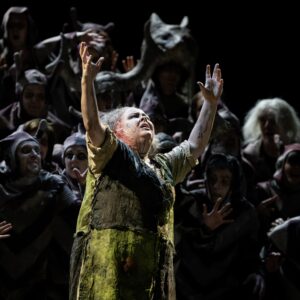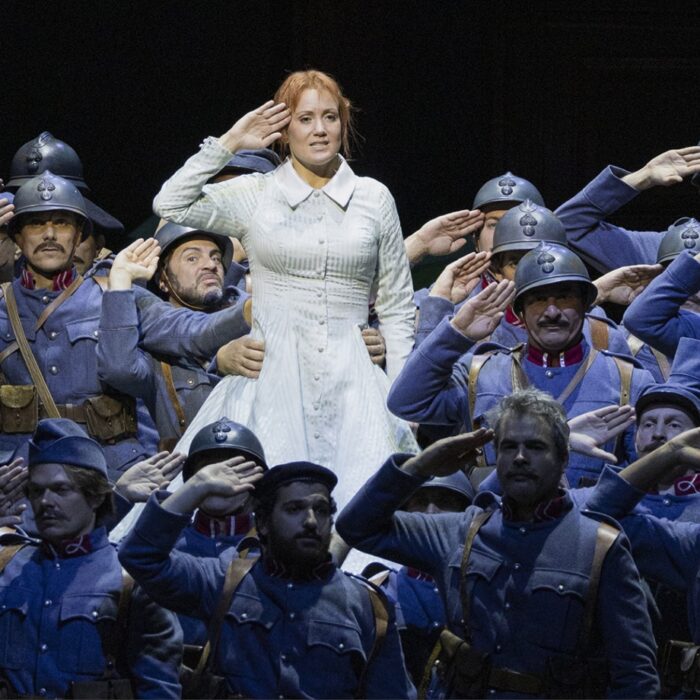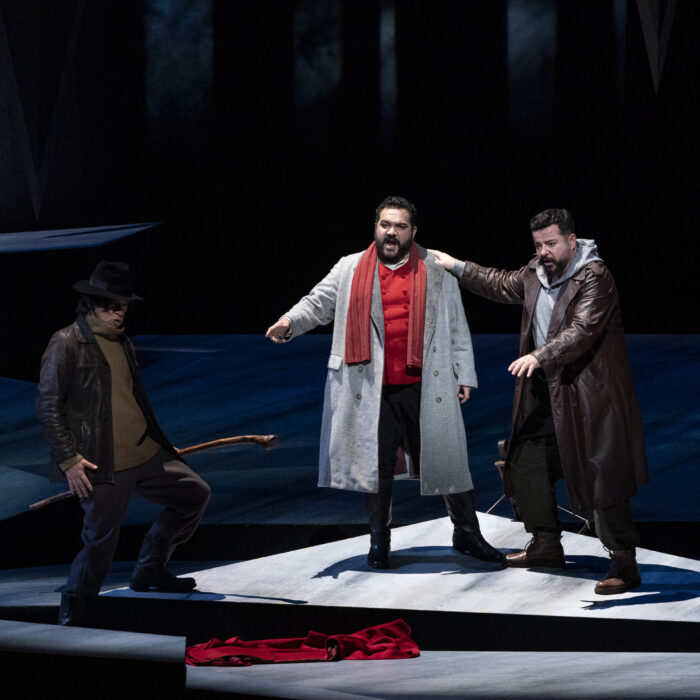
Royal Opera House 2022-23 Review: Il Trovatore
By Mike HardyIf you’re not fully conversant with the tale that is the centerpiece of one of Giuseppe Verdi’s most celebrated and performed works, “Il Trovatore,” then I highly recommend a little further reading and research before attempting to digest this opera. It may well help to alleviate some of the confusion in following the plot.
There’s little one can do, however, to prepare for the bizarre visual onslaught of comedic soldiers, ghouls, and acrobatic demons that prance, dance, and catapult themselves across an otherwise stark and totally unimaginative set. Likewise, acquainting oneself with the plot beforehand doesn’t necessarily guarantee that one won’t find this tale of jealousy, rage, murder, witches, vengeance, immolation, and gruesome infanticide any more palatable or digestible. Still, at least there is a little unrequited love thrown in for good measure, as befits most operas.
Of course, much of opera is centered on stories that are frequently well outside the realms of credibility.
It beggars belief that such a production could have ever been met with such unanimous public approval when it was first staged in the mid-nineteenth century. However, the music of Verdi at its finest can assuage anything, particularly when under the baton of Maestro Antonio Pappano.
Confusion on Stage
Any chance that this gruesome and most pernicious of tales could convey a smattering of plausibility were totally lost when the curtain lifted on Act one and revealed an odd assortment of soldiers and guards lying around in odd states, some prone, as though massacred at battle. The set is comprised of a wooden staircase that fills the expanse of the stage, purporting to be the “The Palace of Aljafería,” in Spain. We learn that the multitude of seeming corpses are actually sleeping guards. They become awakened by their commander, Ferrando, and instructed to be on the lookout for some Troubadour, the rival of their ultimate leader, the Count di Luna.
Just for good measure, he keeps them on their toes with a tale of how the castle is supposedly haunted by a witch who was burned at the stake 15 years previously for casting an “evil eye” on the Count’s baby brother. The baby then went missing and was subsequently found burned to death on the same pyre. Apparently thrown there by a mysterious gypsy woman, acting in revenge for her own mother, the witch, burning at the stake. Alas, it later transpires that she was so enraged and crazed, that she actually threw her own child on the fire by mistake.
Still keeping up with the story? I’ll leave you to uncover the rest of it by yourself.
Suffice to say, that this tale is made less believable here by the somewhat unfathomable actions of the guards. Their naïve prancing and dancing punctuate key elements of the score throughout their presence on stage. Worse still, several key moments of the opera are denigrated by the incessant acrobatics of strange, feline-like demons, clearly emulating the fantasies of Hieronymus Bosch. These supple and athletic endeavors were impressive in their own right. For me, however, they served only to detract from the melodrama.
Remarkably, the wooden staircase set forms the backdrop to all four acts and it uses only occasional and subtle set drop-downs to accompany the narrative.
First Class Cast
As already insinuated, the music was very much the savior of this production, and that unquestionably extended to the singing which was universally first class.
American soprano Rachel Willis-Sørensen performed the role of Leonora. This provides a perfect vehicle for her to display her impressive and substantial vocal talents. Full-bodied in the upper register, beautifully rich and resonant in the lower. She also has the wonderful ability to resort to expressive pianissimos. She paints beautiful phrases with the trills and ornaments of her coloratura. Her “Tacea la notte placida,” where she confides with her confident, Ines, and declares her love for the Troubadour, is most endearing.
However, for me, Willis-Sørensen’s real triumph occurs in the final act when she sings a majestic and impassioned “D’amor sull’ali rosee.” She was positively entrancing. Likewise, her duet with her lover, “Miserere,” where she further pledges her love to him beneath the tower where he is imprisoned, is also captivating and beautifully phrased with restrained control. The distant vocals of Manrico blended with her own.
Hardly any review of American tenor Gregory Kunde goes by without some mention of his advancing years, or references about him being a veteran. I am frequently told by other artists about how well he sings for his age, and I prefer to assert this, period. Kunde knows his own voice, its limits, and its capabilities, and he employs his vast range of learned techniques to maximum effect. His instrument is beautifully clarion. He reaches every nook and cranny of the house with a steely clarity and tone. In his offstage moments, where he sings “Deserto sulla terra,” and again in the “Miserere” duet, his voice floats beautifully and distinctly. He exudes a most evocative quality. His fourth act, with his Mother Azucena, in “Madre, non dormi?” is particularly emotive. His interactions with his love, Leonora, are entirely convincing, and his stage presence and kinesics entirely belies his age. His “Ah sì, ben mio” is impassioned and quite beautiful, as is his heartfelt “L’onda de’ suoni mistici” duet with Leonora which immediately follows. He opts for brevity in the final high C on “All’armi!” of the infamous “Di quella pira” caballeta. However, the remainder of the piece is sung with solid conviction and confidence.
Jamie Barton in the role of Azucena, is an unequivocal tour de force. Her voice is considerably skilled and beautifully toned. Her lower register is utterly sumptuous, almost baritonal. She unquestionably cements her position as one of the finest mezzo-sopranos in the world. Moreover, her dramatic skills are exemplary and her portrayal of a tortured, anguished, and haunted old woman was utterly spellbinding. Her pain was palpable. This is a role she first sang in 2015 and she clearly knows her way around the living hell of this character. Her “Stride la vampa!” sets out her credentials as a woman on the edge of derangement, but her fourth act duet and interactions with Manrico, especially in the duet “Madre, non dormi?” is most evocative. She presents a battled, weary, and vulnerable tormented soul.
Her tormentor, and rival to Manrico, the Count di Luna is portrayed here with style and panache by French Baritone Ludovic Tezier. He is frequently lauded as the best Verdian baritone around. He combines brooding menace with an almost curious fragility. His “Il balen del suo sorriso,” in the second act where he declares his love for Leonora, is truly compelling. His poignancy is almost tangible. The aria brought heartfelt applause from the audience. I felt, however, in the fourth act where he realizes he has been tricked by Leonora, who consumes poison in order to avoid the intimacy which she has promised him, and subsequently discovers that by dispatching his rival Manrico, he has actually slaughtered his own brother. Well, I did say this was a story full of complications. His performance was somewhat stolid and bereft of the emotional turmoil that such a scenario surely would have elicited.
Almost matching Tezier in vocal prowess, if not exceeding him in menace, is Roberto Tagliavini in the role of the Count’s henchman, Ferrando. His every move is accompanied by devilish incarnations that leap and posture around him in the opening act. His sonorous bass voice exhibits a rich and resonant timbre.
The chorus was an excellent accompaniment. The rousing and invigorating “Anvil Chorus,” and particularly the “Miserere ’duet,” produced an exquisite, angelic backdrop.
Maestro Antonio Pappano easily triumphs with the Orchestra of the Royal Opera House. But one would really expect nothing less. Verdi knew this libretto was potentially contentious and repulsive. It demanded an unimpeachable score.
Bizzare Direction
The problem with this opera, for me, is not so much the story, but its portrayal. Director Adele Thomas, along with designer Annemarie Woods, clearly opted for the bizarre, allegorical route here. Minimalist staging with no real set design to differentiate between each scene other than simple cut-out and suspended drops. The naïve and decorative flourishes accentuate certain key points, however, she elected to have the tale visually depicted by oddly dressed performers whose antics were devoid of any real purpose.
American humourist Erma Bombeck said, “There is a thin line that separates laughter and pain, comedy and tragedy, humour and hurt.” This was a sentiment echoed by many writers across the ages. The problem here is that Thomas erased the line completely and opted for some weird, slapstick approach that incorporated madcap antics that were more redolent of 1960’s pantomime. The “Anvil Chorus” performers, though magnificent in voice, were dressed in chevron striped costumes with an array of headgear that depicted skulls, horned animals and ghouls. An assortment of devils frequently popped up out of trapdoors. This gesture was made to the audience before cartwheeling off stage to reappear elsewhere in a manner that, ostensibly, had no bearing to the story at hand.
I will commend the artists who lay strewn across the floor in the final act. Seemingly all had broken limbs, laid prone at angles. They were cleverly designed mannequins, until they arose as one before slowly marching offstage in perfect unison. A lone, yet unquestionably spellbinding moment in an otherwise visually humdrum affair. The few moments of real tension mustered were predominantly courtesy of lighting designer Franck Evin who managed to accentuate some key moments with concentrated spotlights that isolated the characters and evoked a little atmosphere.
Adele Thomas is, unquestionably, a talented award-winning director. However, instead of focusing her creative talents on telling a story, she resorts to a route that so many progressive directors seem to pursue. She radically deviates from the intended visions of the composer and seeks sensationalism instead.



